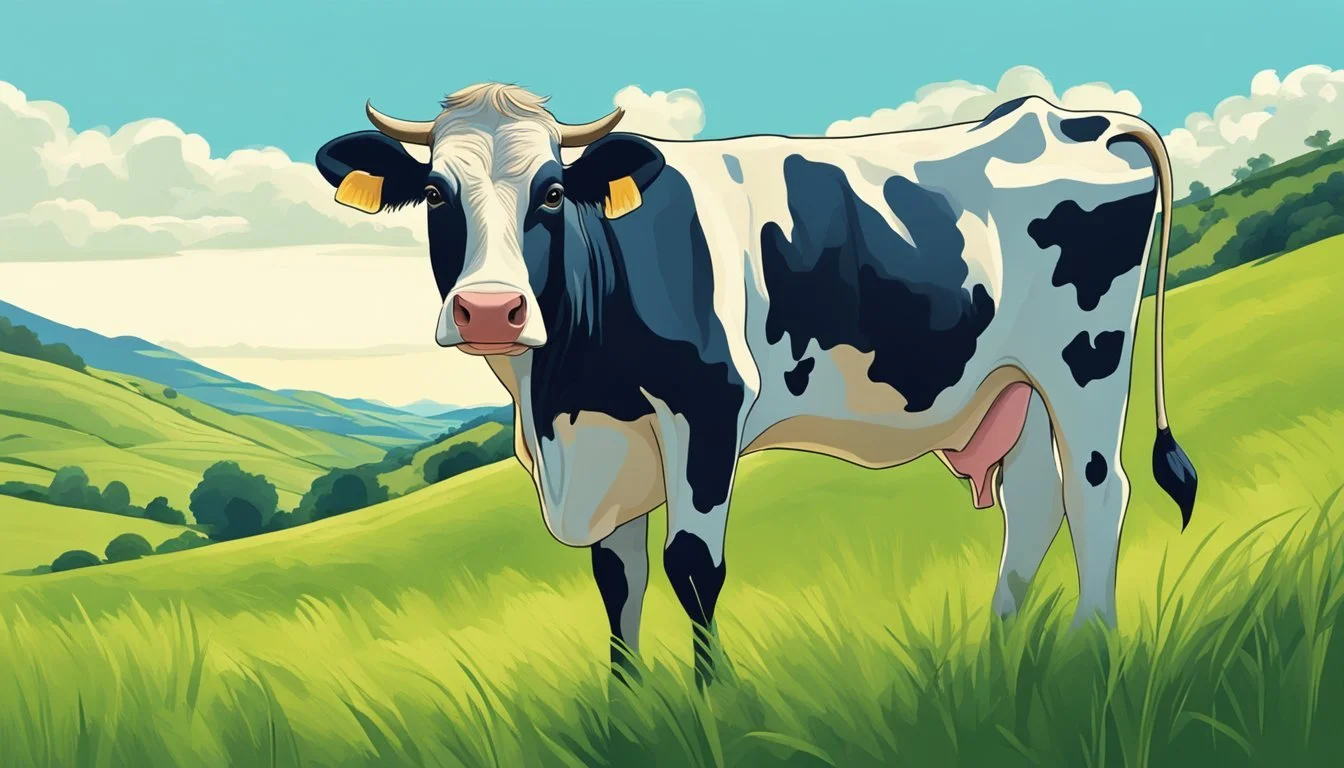Exploring the Rich Fatty Acid Profile of Milk
Nutritional Insights for Carnivores
Milk, a staple in many diets, offers an array of fatty acids essential for health. For those following a carnivore diet, understanding the fatty acid profile of milk is crucial. Milk contains a unique blend of saturated, monounsaturated, and polyunsaturated fatty acids that can support overall health.
Grass-fed butter, derived from cows that graze on natural grass, contains higher levels of beneficial omega-3 fatty acids, which are known to be anti-inflammatory and support brain function. These fats are particularly relevant for individuals on a carnivore diet, as they provide essential nutrients that might otherwise be lacking.
Goat and sheep milk are notable for their medium-chain fatty acids, such as caproic, caprylic, and capric acids. These contribute to their distinct flavors and offer additional health benefits, including improved digestion and a more favorable omega-6 to omega-3 ratio, compared to cow milk. This makes these milk varieties a nutritious option for those prioritizing fat quality in their carnivore diet.
The Basics of Fatty Acids in Milk
Fatty acids in milk play a crucial role in both the nutritional and physiological welfare of those who consume dairy products. This guide focuses on the types and benefits of these fats, providing a detailed understanding of their importance in a carnivore’s diet.
Understanding Fats
Milk contains a blend of various fatty acids, including saturated fats, monounsaturated fats, and polyunsaturated fats. Among the key fatty acids are C12:0, C14:0, C16:0, C18:0, and C18:1 c9.
Saturated fats like C16:0 (palmitic acid) are abundant in milk and make up a significant portion of milk fat. These fats are important sources of energy and structural components in cells.
Monounsaturated fats and polyunsaturated fats are present in smaller amounts but are essential for maintaining cellular health and metabolic function. The presence of essential fatty acids such as omega-3 and omega-6 in milk is particularly noteworthy, as they are vital for proper cellular processes.
Health Benefits of Milk Fats
Consuming milk fats offers several health benefits. Saturated fats in milk are a vital energy source. Additionally, they play a role in hormone production and the absorption of fat-soluble vitamins like A, D, E, and K.
Omega-3 and omega-6 fatty acids in milk contribute to heart health by maintaining cholesterol levels and reducing inflammation. These fats are also crucial for cognitive functions and overall brain health.
Milk fats provide a rich source of cholesterol, which is essential for producing vital hormones and maintaining cell membrane integrity. The combination of these fatty acids, vitamins, and minerals in milk contributes to a nutritionally balanced diet, promoting overall bodily health.
Milk, therefore, stands as a nutritious component in a carnivorous diet, delivering a range of essential fatty acids that support various physiological functions.
Carnivore Diet Fundamentals
The carnivore diet emphasizes the exclusive consumption of animal-based foods, focusing on meat, animal fats, and proteins. This section delves into the key aspects of the diet with particular attention to the role of dairy, specifically milk.
Defining the Carnivore Diet
The carnivore diet involves consuming only animal products, which include meat, fish, eggs, and some dairy. It avoids all plant-based foods such as fruits, vegetables, grains, nuts, and seeds.
This diet aims to replicate the presumed eating habits of early humans, relying heavily on nutrient-dense animal foods. Adherents of the carnivore diet benefit from a high intake of proteins and animal fats. These nutrients support muscle growth, energy levels, and bodily functions.
Common foods on a carnivore diet include:
Red meat: Beef, lamb, pork
Poultry: Chicken, turkey
Fish and seafood: Salmon, sardines, shrimp
Organ meats: Liver, kidneys, heart
This regime often appeals to those seeking simplicity in food choices and those addressing specific health issues through diet adjustments.
Milk's Role in a Carnivore Diet
Milk, while animal-based, is a subject of debate among carnivore diet proponents. Some practitioners include milk and dairy products, while others avoid them. Milk provides a valuable source of fats and proteins. It also contains essential nutrients like calcium, vitamin D, and potassium.
When whole milk is consumed, it offers a balanced profile of fats, including omega-3 fatty acids and conjugated linoleic acid (CLA). These fatty acids contribute to various health benefits, such as reducing inflammation and supporting heart health.
However, lactose intolerance can be a concern for some individuals. In such cases, lactose-free options or fermented dairy products like yogurt and cheese might be considered.
Thus, while milk can fit within the carnivorous framework, it depends on personal tolerance and dietary goals.
Comparison of Milk with Other Animal Products
Milk, rich in essential fatty acids, often pairs with various animal products in diets. Comparing milk to other animal products reveals differences in fatty acid profiles, nutritional benefits, and potential health impacts.
Milk vs. Meat
Milk and meat both provide essential nutrients but vary greatly in fatty acid content. Milk, particularly from ruminants, contains significant levels of omega-3 and omega-6 polyunsaturated fatty acids (PUFAs), vital for metabolic and brain functions.
Meat:
Beef and lamb: High in saturated fats, with some omega-3s depending on the animal's diet.
Pork: Lower in PUFAs compared to ruminants' milk, predominantly saturated and monounsaturated fats.
Poultry: Contains moderate omega-6 PUFAs but less omega-3s compared to milk.
Meat protein is dense, contributing to muscle building, whereas milk offers a broader range of beneficial fatty acids.
Dairy and Eggs
Eggs and dairy products such as cheese and yogurt have complementary nutrient profiles.
Eggs:
Rich in omega-3 if from pastured or omega-3 enriched hens.
Contain significant cholesterol but also high-quality protein.
Dairy:
Cheese and yogurt: Provide probiotics, calcium, and vitamin D.
Fatty acid profile: Similar to milk, with beneficial PUFAs that support heart health.
While eggs provide highly bioavailable protein, dairy excels in delivering diverse micronutrients and fatty acids essential for various body functions.
Dairy vs. Fish and Seafood
Fish and seafood, particularly oily varieties, are known for their beneficial omega-3 fatty acids.
Fish:
Salmon and eel: High in EPA and DHA, types of omega-3s, crucial for cardiovascular health.
White fish: Lower in fat but still a good source of omega-3s.
Dairy:
Good source of omega-3 and omega-6 but in lower concentrations compared to fatty fish.
Offers additional nutrients like calcium and vitamin A, not as prevalent in most fish.
Fish usually provides higher levels of specific omega-3s (EPA and DHA) than dairy, making it particularly beneficial for heart and brain health. Dairy, in contrast, brings a balance of essential PUFAs with additional vitamins and minerals that enhance overall nutrition.
Nutritional Considerations and Health Implications
The fatty acid profile of milk offers diverse health benefits, impacting weight management, digestive health, and the risk of various chronic diseases, including heart disease and diabetes.
Weight Management
Milk's fatty acids can influence weight management. Certain studies suggest that the conjugated linoleic acid (CLA) in milk may help reduce body fat in some cases. Milk fats also provide a feeling of satiety, reducing overall calorie intake.
For people trying to manage their weight, incorporating milk with moderate fat content might be beneficial. It allows them to enjoy its nutritional properties without excess caloric intake.
Digestive Health
Fatty acids in milk, especially butyric acid, are significant for digestive health. Butyric acid serves as a key energy source for colonic cells, promoting healthy gut function and may play a role in reducing inflammation.
Fermented milk products like yogurt contain probiotics. These probiotics work together with milk's fatty acids to support gut health, enhancing the balance of gut bacteria and improving digestion.
Milk and Chronic Diseases
The relationship between milk consumption and chronic diseases such as heart disease, diabetes, and cancer has been widely studied. Saturated fatty acids in milk have been linked to higher cholesterol levels. This connection raises concerns about heart disease.
However, milk also contains other beneficial components such as omega-3 fatty acids, which may help lower blood pressure and reduce the risk of heart disease. Additionally, some research suggests that regular consumption of milk might lower the risk of colon cancer and type 2 diabetes due to its comprehensive nutrient profile.
Incorporating Milk in Various Diets
Milk can be a versatile addition to many diets, providing essential nutrients like calcium and vitamin D. Its application in specific diets such as the ketogenic and paleo diets varies based on dietary rules and goals.
Milk in a Keto Diet
The ketogenic diet, known for its low-carb, high-fat composition, can potentially include milk. However, traditional cow’s milk contains lactose (a carbohydrate), which might disrupt ketosis.
Unsweetened almond milk or coconut milk are suitable alternatives with lower carb content. They also offer healthy fats that align with keto principles. For those seeking dairy, heavy cream or full-fat cream can be used sparingly.
Milk’s nutritional benefits, such as calcium and vitamin D, remain crucial. Ensure to check labels for carb content to maintain ketosis.
Milk and the Paleo Diet
The paleo diet emphasizes whole foods similar to those consumed in the Paleolithic era, excluding dairy. Consequently, traditional cow’s milk is typically avoided.
Alternatives like almond milk, coconut milk, and cashew milk fit within paleo guidelines, providing similar nutritional benefits without dairy. These options often contain vitamins and minerals beneficial for bone health and overall wellness.
Homemade versions of these alternatives are preferred to avoid added sugars and preservatives, aligning better with paleo principles.
Dairy Products and Derivatives
Milk fat plays a crucial role in the texture, flavor, and nutritional profile of various dairy products. It's essential to understand the impact of fatty acids in products like butter, cream, cheese, and yogurt.
Butter and Cream
Butter comprises about 80% milk fat, making it rich in saturated fatty acids. These fats contribute to butter's solid nature at room temperature and its distinctive flavor. It's produced by churning cream, separating fat from buttermilk.
Cream, similarly, is high in milk fat and is available in various types, such as heavy cream and light cream. Heavy cream contains a higher fat content, making it ideal for whipping and creating a rich mouthfeel in dishes.
Both butter and cream are sources of bioactive fatty acids. These include conjugated linoleic acid (CLA), which may have health benefits when consumed in moderation.
Cheeses and Yogurt
Cheese varies widely in fat content, influenced by the type of milk, aging process, and production methods. Hard cheeses like cheddar contain higher levels of fat compared to fresh cheeses like cottage cheese.
Yogurt, especially the full-fat variety, also contains milk fat. The fermentation process adds beneficial probiotics but doesn't significantly alter the fat content unless it's specifically low-fat or fat-free.
Cheese and yogurt are excellent sources of calcium and protein, besides their fat content. These products also provide omega-3 fatty acids, especially when derived from milk of grass-fed animals.
Potential Concerns and Misconceptions
Milk, while nutrient-rich and beneficial for many, can present certain challenges, especially regarding lactose intolerance, milk allergies, and the ongoing debate about saturated fats. Understanding these concerns is crucial for making informed dietary choices.
Lactose Intolerance and Milk Allergies
Lactose intolerance affects a significant portion of the global population. Individuals with this condition lack enough lactase, the enzyme needed to digest lactose found in milk. Symptoms include bloating, gas, diarrhea, and abdominal pain after consuming dairy products. This can lead many to avoid milk entirely, despite its nutritional benefits.
On the other hand, milk allergies are immune responses to milk proteins, such as casein or whey. Symptoms can range from mild, like hives and itching, to severe, such as vomiting, anaphylaxis, and difficulty breathing. Individuals with milk allergies must often eliminate milk and dairy products completely from their diet.
The Saturated Fat Debate
Milk contains saturated fats, which have been historically linked to cardiovascular disease. However, recent research suggests that not all saturated fats have the same impact on heart health. Milk fat includes a variety of fatty acids, some of which, like short- and medium-chain fatty acids, may have neutral or even beneficial effects on cardiovascular health.
The concern arises when these saturated fats are consumed in large quantities or in the context of a diet high in unhealthy fats. Moderation and balance, along with regular check-ups and appropriate medications for those with existing health conditions, can make milk a safe part of a carnivore's diet.
Taking into account these aspects, consumers can make better-informed decisions about their milk intake and address potential health issues effectively.
Milk in Culinary Traditions
Milk has been an indispensable ingredient in various culinary traditions around the world. It is used in both food preparation and beverage pairings, enhancing flavor and nutritional value.
Dairy in Cuisine
In numerous cultures, milk serves as a fundamental component in a wide range of dishes. In Italian cuisine, for example, milk is a key ingredient in making creamy risottos and rich panna cotta desserts. French cuisine relies heavily on milk for classic béchamel sauce, a staple in dishes like croque-monsieur and lasagna.
In Indian cuisine, milk is used to create a variety of dairy-based sweets such as gulab jamun and rasmalai. Additionally, Middle Eastern cuisine features yogurt-based dishes like labneh, which is made from strained yogurt and often served with olive oil and herbs.
Milk in these dishes not only enhances flavor but also adds essential nutrients. The presence of calcium and protein in milk contributes to the nutritional profile of these foods, making them both flavorful and healthy options.
Milk and Beverage Pairings
Milk’s versatility extends to its role in beverages. Coffee and tea are two popular drinks that often feature milk. A latte, made with steamed milk and espresso, highlights milk’s ability to create a smooth, creamy texture. In contrast, a traditional English tea with milk balances the bitterness of the tea leaves, making for a comforting drink.
In various cultures, milk-based drinks are cherished for their unique flavors and health benefits. Indian masala chai, a spiced tea blend with milk, combines aromatic spices like cardamom, ginger, and cinnamon. In Middle Eastern countries, milk is sometimes paired with herbal teas to enhance their soothing properties.
In these beverages, milk not only contributes to the overall taste but also offers nutritional benefits. The natural fats and proteins in milk help to create a satisfying and energizing drink that can be enjoyed at any time of the day.
Beyond Nutrition: Other Considerations
Understanding the fatty acid profile of milk extends beyond nutritional benefits, encompassing environmental and ethical impacts, as well as economic factors. These aspects provide a holistic view of milk production and consumption.
Environmental and Ethical Impact
Milk production has significant environmental implications. Intensive dairy farming can lead to greenhouse gas emissions, water pollution, and deforestation. Methane emitted by cows contributes to climate change, while fertilizers and pesticides contaminate water supplies, harming ecosystems.
From an ethical standpoint, concerns over animal welfare in factory farms are paramount. Harsh living conditions and overmilking are often cited issues. Sustainable and humane farming practices can mitigate these impacts, promoting healthier lifestyles for both animals and humans.
Economic Factors
Milk production is also shaped by economic considerations. Feeding strategies and diet compositions directly affect the fatty acid profiles of milk, impacting production costs. Efficient feeding methods can enhance profitability for farmers by optimizing milk quality without excessive expenditure.
Market demand for milk with favorable fatty acid profiles influences pricing and availability. Consumers are increasingly willing to pay for high-quality milk that aligns with health trends and ethical standards. This economic dynamic drives innovation in dairy farming practices and product offerings.
The Future of Milk Consumption
The future of milk consumption is being shaped by ongoing scientific research and innovations in dairy production. As new health discoveries emerge and dairy farming techniques evolve, consumers can expect significant changes in how milk is produced and consumed.
Scientific Research
Numerous studies have investigated the health impacts of different fatty acids in milk. For example, research highlights the benefits of increasing unsaturated fatty acids (UFAs), especially omega-3 fatty acids, which are linked to improved cardiovascular health.
Moreover, scientific evidence suggests not all saturated fatty acids (SFAs) are harmful. Some types, like those found in milk, might have less detrimental effects compared to other dietary sources.
Continued research is essential to fully understand these health impacts and inform better dietary recommendations. Scientists are also exploring ways to modify cow diets to enhance the beneficial fatty acid content in milk.
Innovation in Dairy Production
Innovations in dairy production are aiming to create milk with improved health benefits. One approach involves altering the feed given to dairy cows. For instance, diets rich in omega-3 sources like linseed can increase omega-3 levels in milk.
Advancements in genetic engineering may also play a role. By selecting for specific traits, producers can breed cows that naturally produce milk with more favorable fatty acid profiles.
In addition, sustainable farming practices are being developed to ensure that these innovations are environmentally friendly. This includes reducing greenhouse gas emissions and enhancing animal welfare.
By embracing these advances, the dairy industry can produce healthier milk while maintaining sustainability.
Conclusion
The fatty acid profile of milk offers a diverse array of nutritional benefits. It encompasses a balance of saturated and unsaturated fatty acids that play significant roles in health.
Milk contains short-chain, medium-chain, and long-chain fatty acids, each contributing uniquely to its overall nutritional quality.
Studies have highlighted that diets rich in saturated fatty acids, particularly myristic acid, can increase milk fat production. Additionally, variations in fatty acid profiles exist between species. For example, bovine milk typically contains higher levels of short-chain fatty acids compared to human milk.
Key Fatty Acids in Milk:
Saturated Fatty Acids (SFA): Common in many dairy products.
Unsaturated Fatty Acids (UFA): Includes both monounsaturated (MUFA) and polyunsaturated (PUFA) types, beneficial for heart health.
Myristic Acid (C14:0): Known for its role in milk fat enrichment.
Modifying the fatty acid composition through dietary interventions can further enhance milk's health benefits. This makes milk an adaptable and valuable component of a balanced diet for consumers.









